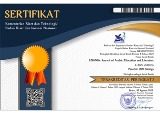Tingkat Kecemasan Berbicara Bahasa Arab di Kalangan Pelajar Sebuah Universitas di Jawa Tengah
Abstract
Keywords
Full Text:
PDFReferences
Alsowat, Hamad H. Foreign language anxiety in higher education: A practical framework for reducing FLA. European Scientific Journal, Vol. 12 (7), 193-220, 2016.
Aydın, B. A Study of Sources of Foreign Language Classroom Anxiety in Speaking and Writing Classes. Unpublished doctoral thesis, Anadolu University, Eskişehir., 1999.
Balemir, Serkan Hasan. The Sources of Foreign Language Speaking Anxiety and the Relationship Between Proficiency Levels and Degree of Foreign Language Speaking Anxiety. Unpublished master dissertation, Bilkent University, Ankara, 2009.
Cagatay, Sibel. Examining EFL students’ foreign language speaking anxiety: The case at a turkish state university. Procedia-Social and Behavioral Sciences, 199, 648-656, 2015.
Chua, Y.P. Mastering Research Methods. Malaysia: McGraw-Hill Education, 2013.
Cohen, Louis., Manion, Lawrence., & Morrison, Keith. Research Methods in Education. New York: Routledge, 2007.
Doqaruni, Vahid Rahmani. A quantitative action research on promoting confidence in a foreign language classroom: Implications for second language teachers. i.e.: inquiry in education: Vol. 5: Iss. 1, Article 3, 2014.
Eaton, S.E. Global Trends in Language Learning in the Twenty-first Century. Calgary: Onate Press, 2010.
Elaldı, Şenel. Foreign language anxiety of students studying English Language and Literature: A sample from turkey. Educational Research and Reviews, 11 (6), 219-228, 2016.
Hashemi, Masoud & Abbasi, Moghtada. The role of teacher in alleviating anxiety in language oral. International Research Journal of Applied and Basic Sciences, 4 (3), 2013.
Horwitz, Elaine K., Horwitz, Michael B., & Cope, Joann. Foreign language classroom anxiety. The Modern Language Journal, Vol 70 (2), 125-132, 1986.
Lay Yoon Fah., & Khoo Chwee Hoon. Introduction to Statistical Analysis in Social Sciences Research (Series 1). Malaysia: Venton Publishing, 2009.
Lileikienė, Asta., & Danilevičienė, Lina. Foreign language anxiety in student learning. Baltic Journal of Sport & Health Sciences, Vol. 101 (3), 18-23, 2016.
Nur Afiqah Ab Latif. A study on English language anxiety among adult learners in university teknologi Malaysia. Procedia-Social & Behavioral Sciences 208, 223-233, 2015.
Oxford, Rebecca L. Anxiety and the language learner: New insight. In Jane Arnold, Affect in Language Learning (pp. 58-67). United Kingdom: Cambridge University Press, 1999.
Öztürk, Gökhan., & Gürbüz, Nurdan. Speaking anxiety among turkish efl learners: The case at a state university. Journal of Language and Linguistic Studies, 10 (1), 1-17, 2014.
Phillips, Elaine M. Decreasing language anxiety: Practical techniques for oral activities. In Young, D.J (Eds.), Affect in foreign language and second language learning: a practical guide to creating a low-anxiety classroom atmosphere (pp. 124-143). USA: The McGraw-Hill Companies, 1999.
Sieber, Joan E. Development of the concept of anxiety. In Sieber, Joan E., O’Neil, Harold., & Tobias, Sigmund. Anxiety, learning, and instruction (11-22). New Jersey: Lawrence Erlbaum Associates, Inc, Publisher, 1977.
Sieber, Joan E. How shall anxiety be defined. In Sieber, Joan E., O’Neil, Harold., & Tobias, Sigmund. Anxiety, learning, and instruction (22-40). New Jersey: Lawrence Erlbaum Associates, Inc, Publisher, 1977.
Springer, Ken. Educational Research: A Contextual Approach. USA: John Wiley & Sons Inc, 2010.
Sumintono, Bambang., & Widhiarso, Wahyu. Aplikasi Pemodelan Rasch Pada Assessment Pendidikan. Cimahi: Trim Komunikata, 2015.
Tercan, Gülşah., & Dikilitaş, Kenan. EFL students’ speaking anxiety: A case from tertiary level students. ELT Research Journal, 4 (1), 16-27, 2015.
Worde, Renee von. Students’ perspectives on foreign language anxiety. Inquiry, Volume 8 (1), 1-15, 2003.
Wright, B., & Stone, M. Measurement Essentials (2nd ed.). Delaware: Wide Range, 1999.
Young, D.J. Affect in foreign language and second language learning: A practical guide to creating a low-anxiety classroom atmosphere. In Young, D.J (Eds.), Affect in foreign language and second language learning: a practical guide to creating a low-anxiety classroom atmosphere (pp. 124-143). USA: The McGraw-Hill Companies, 1999.
DOI: https://doi.org/10.18326/lisania.v1i2.1-19
Refbacks
- There are currently no refbacks.
Copyright (c) 2017 LISANIA: Journal of Arabic Education and Literature
View My Stats







